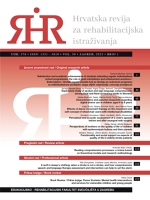Reading comprehension processes: a review based on theoretical models and research methodology
Reading comprehension processes: a review based on theoretical models and research methodology
Author(s): Antonija Blaži OstojićSubject(s): Theoretical Linguistics, Applied Linguistics, Language acquisition, Psycholinguistics, Methodology and research technology
Published by: Sveučilište u Zagrebu, Edukacijsko-rehabilitacijski fakultet
Keywords: reading comprehension; theory; methodology; language processing;
Summary/Abstract: Reading comprehension is a complex, multifaceted process in which a number of components are appropriately and often simultaneously activated. The importance of different background subprocesses, its complex nature, as well as the interconnection of various components has been demonstrated by various ‘models of reading and reading comprehension’. Based on these models, assessment methods and materials for reading comprehension are developed. However, the models and assessment materials developed so far are mostly derived from research on languages with nontransparent orthography (e.g., English). Therefore, the question arises regarding the extent to which they can or should be applied in languages with shallow, transparent orthography (e.g., Croatian) that have clear and consistent relationships between letters and sounds, as opposed to languages with deep orthography. The main aim of this study was to present a brief review of prominent reading comprehension models and their interconnections through specific levels of language processing (single word, sentence, discourse), as well as to discuss the methodological aspects of assessing reading comprehension processes arising from the presented theoretical models. Motivated by the fact that there is a lack of studies on models and assessment materials in languages with transparent orthography, the application of existing models and assessment methods will be discussed in the context of transparent orthography languages. This study provides comprehensive insights, based on theory, on the key elements to consider when developing an assessment method/tool for reading comprehension, both for research or diagnostic purposes.
Journal: Hrvatska revija za rehabilitacijska istraživanja
- Issue Year: 59/2023
- Issue No: 1
- Page Range: 122-143
- Page Count: 22
- Language: English

